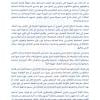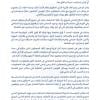
The White Helmets Introduce Disaster Response Training Program for Civilians in Northwestern Syria
Community involvement played a significant role during the devastating earthquake, contributing to rapid response and the surmounting of numerous obstacles. Building the capacities of local residents will play a substantial role in enhancing response capabilities and effectively contributing to life-saving efforts.
The White Helmets launched a vital initiative to enhance community participation in disaster response by providing training courses aimed at building disaster response capabilities among residents in northwestern Syria.
The prolonged war waged by the Assad regime and Russia has had profound repercussions on communities, resulting in significant vulnerabilities. These vulnerabilities have left the population exposed to a wide spectrum of disasters, including those stemming from the ongoing war, in addition to the risks posed by natural disasters. The most recent natural disaster was the earthquake on February 6th, which marked Syria's most significant natural catastrophe in decades. In response to these challenges, it is of paramount importance to equip the local community with the knowledge and skills required for active engagement in disaster response efforts.
Community involvement played a significant role during the devastating earthquake, contributing to rapid response and the surmounting of numerous obstacles. Building the capacities of local residents will play a substantial role in enhancing response capabilities and effectively contributing to life-saving efforts.
Course Duration
Each training course spans three days with seven hours of material encompassing both theoretical and practical sessions covering a range of fundamental disaster management topics. Geographically, the training program encompasses all areas of northwest Syria, and training sessions are currently ongoing. It is anticipated that the number of trainees will reach 2,500 individuals, including both male and female participants.
Selection Criteria for Participants:
In order to ensure the effectiveness of the training program and adequately prepare participants for disaster response, specific selection criteria have been established, which include:
- Residency: Candidates must be residents of the training region, guaranteeing their active engagement within the local community.
- Educational Background: While not obligatory, possessing a secondary education certificate is preferred.
- Dedication: Candidates are required to demonstrate their commitment to adhere to training schedules, thus optimizing the program's effectiveness.
- Age Range: Participants should fall within the age group of 20 to 40 years, as this age range is typically more physically capable of responding to disasters.
- Physical Fitness: Prospective participants are expected to be in reasonably good physical condition, enabling their active participation in the practical aspects of the training.
Training Topics:
- Disaster Management: Participants will familiarize themselves with the fundamental principles of disaster management and gain an understanding of the various stages of disaster response, from preparedness to recovery.
- Risk Analysis: This session equips attendees with the necessary skills to assess and analyze risks and potential vulnerabilities in their region, aiding in better preparedness.
- Evacuation Procedures: The course emphasizes the importance of safe and effective evacuation at the workplace in the event of a disaster. Rapid and efficient evacuation often makes the difference between life and death in disaster situations.
- Search and Rescue Techniques: Participants will receive training on the use of search and rescue equipment, including techniques for locating disaster victims and providing assistance.
- Basic First Aid Principles: Basic principles of first aid are taught, laying the foundation for immediate medical assistance.
- First Aid Techniques: Sessions focus on the practical application of first aid skills, ensuring participants are capable of effectively responding to injuries in disaster scenarios.
- Awareness of Unexploded Ordnance and Chemical Weapon Attacks: Given the specific challenges faced in northwest Syria, understanding the risks posed by unexploded ordnance and chemical weapon attacks is vital for participant safety.
- Fire Safety: Participants will be educated on fire prevention, fire classification, and the proper use of fire extinguishers, both through theoretical instruction and practical exercises.
The Importance of Community Participation in Disaster Response:
- Immediate Response: In disaster scenarios, local populations are often the first responders. Equipping them with knowledge and skills can lead to faster and more effective response efforts.
- Contributing to Saving Lives: Well-prepared communities can reduce the number of casualties and minimize damage and recovery time, thereby contributing to saving lives and reducing overall impact.
- Building Sustainable Capacities: Training local residents enhances their sense of responsibility for disaster response efforts, creating a sustainable capacity for long-term disaster management.
Community participation is one of the primary factors contributing to the success of societies in overcoming disasters and crises. It plays a vital role in ensuring the continuity of life through the planning, management, and implementation of strategies aimed at addressing disasters and their detrimental impacts on health, the economy, psychology, and social aspects. Effective community participation arises from the collaboration of the community and working toward a common goal: managing and overcoming crises while mitigating their destructive physical and psychological effects




